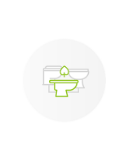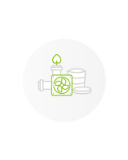Grey Water Q&A
Greywater Q&A
What is Greywater and Why all the Fuss?
Greywater encompasses all household wastewater that is not to do with the toilet (i.e. kitchen, shower, sink, and laundry). Water from the toilet is called black water. The reason why the way which greywater is disposed of is of such concern to the authorities is because of its volume and the presence of potential contaminants.
Water from the kitchen sink is regarded as potentially the most harmful to human health since it can contain salmonella and E. coli from food. Laundry and shower water contain high relatively high concentrations of chemicals, which over time can build up in soil and water sources becoming toxic to plants and animals.
Therefore the Environment Protection Agencies and local councils look closely at how you will be managing the greywater produced by your home if it does not run into a mains sewer. WCTNZ has a few greywater treatment solutions that meet council requirements and won’t break the bank.
Why would I treat my greywater separately from my black (toilet) water?
Simply because it means you also don’t use any water to treat the solid black waste. Also, by keeping black waste separate from greywater you avoid contaminating tens of thousands of litres of water with potentially harmful (pathogenic) bacteria. This means the greywater is much easier to treat to a sufficient standard to be dispersed above or below ground.
On average, Australian households use a total of 240,000 litres of water a year if they have a flushing toilet. According to the Victorian Plumbing Industry Commission, a 5,000L rainwater tank on a 100m2 roof area would yield 60,000L per year. So as well as reducing a household’s water demand by installing a waterless toilet, reusing greywater in an effective manner is also vital to the design of a self-sufficient sustainable home.
How much water can I save?
As much as 40 per cent of household mains-water could be saved by recycling greywater (Source: Alternative Technology Association). Greywater is generated by showers, laundries and sometimes kitchens and.
What is the difference between greywater treatment and diversion?
Depending on your state and local council requirements, greywater diversion products can be reused for watering lawns and gardens with no treatment at all. These products disperse collected greywater within 24 hours to avoid stagnation and septic tank like (anaerobic) conditions. The diversion will manage the majority of your household greywater but kitchen water generally requires treatment before it can be dispersed.
There are three grades of greywater treatment:
Primary –
Secondary –
Tertiary –
What kind of treatment do I need?
When applying to your local council for approval to install a waterless composting toilet you will likely need to have a soil sample from your dispersal area to determine its permeability. If you are fortunate and have good draining permeable soil and have no issues with setbacks from other properties or water sources you should be allowed to treat the water to a primary standard and disperse the water via a small inexpensive subsurface irrigation.
If the results of your soil test show you have poorly draining soil, have a very small block size or are building in a particularly sensitive area (e.g. small islands) you will likely have to treat your water to at least a secondary quality.
Do I need a greywater treatment system with my composting toilet?
If you intend to apply to your local government for a Development Application they will require you to install a state government approved and local council sanctioned grey water treatment system or design. There are very few approved stand-alone systems designed to handle grey water alone. We supply several options.
What will my council require by way of permits to install a waterless toilet and grey water system?
The Development Application requires a site plan drawn by a Geotech engineer, incorporating the flow of the waste water. For the engineer to do this a soil test is required. This determines the amount of trenching. It is important that the engineer is reminded that the composting toilet uses no water and therefore the amount of water entering the trenches is 30% less than in a home with flushing toilets. Trenching is expensive so this represents an important saving. Composting toilets generally require their own trench for any excess urine but this is typically only bathtub size.
What can I use to treat my greywater?
Some states have approved grey water treatment systems. Where this is not the case a holding tank is used. Your council should be able to advise. Please note however that we regularly hear of councils trying to persuade people to install aerated water treatment systems (AWTS), rather than a composting toilet and separate grey water treatment. We understand that this is because councils collect fees from homes with an AWTS but are not able to do so with homes having composting toilets. The plumbing officer may also not understand the importance to the non-urbanised community of water self-sufficiency and the benefit to your land of the end product of a composting toilet. Nor is the council concerned about the energy consumption of an AWTS (two electrical pumps) and the chlorinated water that ends up on your land. We understand the average maintenance cost of an AWTS is $800 (chemicals, electricity, replacing worn out parts and servicing) Should your council prevent you from installing a composting toilet please let us know and we will contact them on your behalf. We also have a list of Geotech engineers who are happy to incorporate composting toilets in your plans. Some geo-techs are in the pockets of AWTS suppliers and will attempt to persuade you to buy an AWTS.
Why use a Nature Clear GWS10?
Low initial and ongoing cost. Low maintenance – The GWS10, installed on a gently sloping block, has no electrical or mechanical components to go wrong or replace. If the there is insufficient fall in the block a small pump well and a (solar powered) pump are required to drain the treated water into the trenches. This minimises the running costs and servicing. The system is self-service and requires only ten minutes per year of your time, until approximately ten years when it should be cleaned out.
Is it easy to install?
It is small and comes with DIY installation instructions. To obtain council approval a plumber needs to sign off on the trenching to state that it has been installed in accordance with the site plan drawn up by your Geotech engineer.
What maintenance is required?
Annually replacing a couple of bags of pine bark and washing a filter cloth. Cleaning out the tank every ten years and replacing fresh filter materials.
What are the annual running costs?
$20
Where can I purchase a pump well?
We can provide a total package that includes the pump well. See our full greywater products offering by clicking here.














